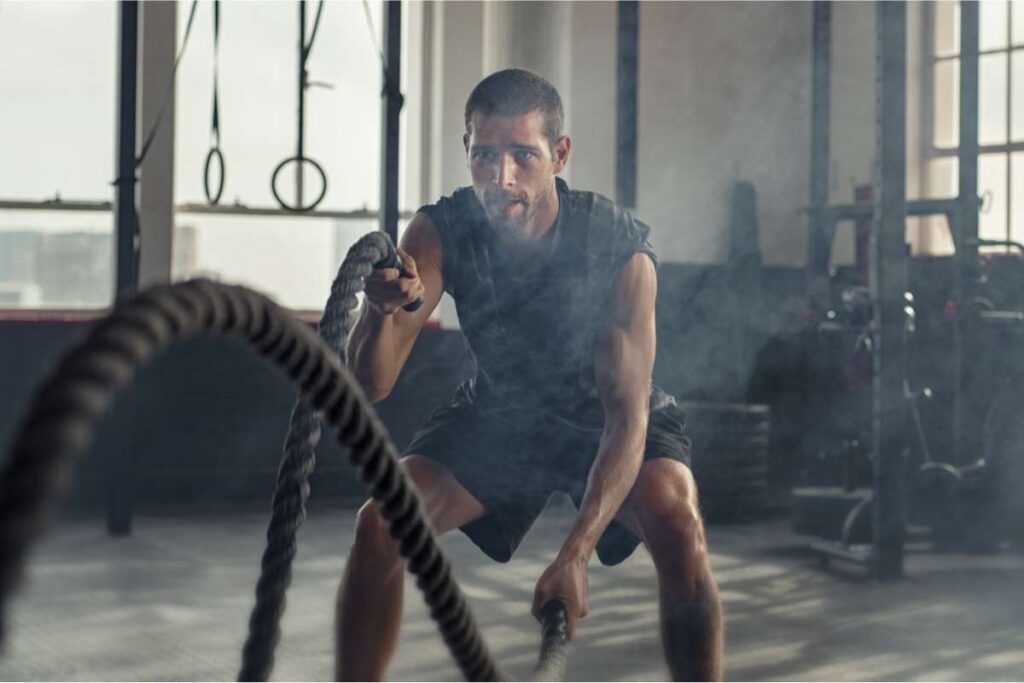This post may contain affiliate links at no additional cost to you. As an Amazon Associate I earn from qualifying purchases. Click to view our full disclosure.
What's inside
How long does it take for HIIT results? It depends on your effort and consistency, but it could be as little as a few weeks.
Sounds fast, right? HIIT has become a lot more popular thanks to fitness pros and influencers, and for good reason. Many are hailing it as the most effective means of increasing fitness and losing body fat.
But is there any merit to this madness, or is it all hype?
Today, let’s discuss HIIT. As a trainer, it’s definitely a method I recommend to clients, but that doesn’t mean it’s right for you.
Keep reading to learn how long it takes to get results, things to consider about adopting this training style, and pro tips to get you the best results.
Let’s dive in.
How long does it take for HIIT results?

HIIT results can be seen between one to four weeks. This can depend on your frequency of training, intensity, and nutrition.
Research suggests you can see increased results in as little as a week when performing HIIT sessions twice per day.
HIIT Meaning
HIIT stands for high intensity interval training. It is characterized by short bursts of near-maximal exercise followed by low-intensity exercise or rest.
Type of HIIT Workouts
Related: How To Burn 1000 Calories Per Day
HIIT is an incredible way to improve endurance, running economy, and VO2 max (maximal oxygen consumption).
Here are the different forms of HIIT workouts to help you decide which is the best match for mixing up your training.
| Type | Workout/Rest | Description |
| One-to-One | 30 sec/30 secs | Great for beginners and all fitness levels. Can be changed to increase workout times and decrease rest as you progress in fitness. |
| Tabata | 20 sec/10 sec | Improve muscular endurance, four-minute total duration. |
| Short Sprint | 8 sec/12 sec | Improves endurance and running economy. |
| Sprint | 30 sec/4 mins | Max effort sprint, requires greater rest time to replenish energy stores. Major improvements to explosive performance and endurance. |
| Tempo Runs | 50 meters/walk back | Improves conditioning, running economy. |
| Sport-Specific | 20 sec/40 sec | Implement HIIT into sport scenarios, to improve performance. |
Things To Consider When Deciding on HIIT

Before you choose to add HIIT to your routine, read this. While getting out and putting in maximal effort can be a great way to improve your fitness, it can be unsustainable unless done properly.
Below are factors that you should consider when building your HIIT routine.
Fitness Level
The amazing thing about HIIT is that you can program your routine to suit your fitness level.
HIIT, as the name suggests, can be intense. Due to the frequent rests, it can be deceptive how hard the body is working during a session.
When creating your HIIT routine, consider starting with shorter intervals and longer rest breaks. This will help you gauge your fitness level.
From here, you can shorten breaks or increase interval duration to match your energy levels, both during your session and for the following session.
Intensity
When you plan your HIIT routine, carefully consider the intensity of your workouts.
If you are new to this style of training, we recommend starting off slow, as described above. While this may sound like an easier route, the intensity of the session can creep up on you quickly.
As you progress, adjust the duration and intensity of your intervals to suit your increasing fitness level.
Duration
Duration of both intervals and the overall HIIT session can greatly affect your results.
Beginners should start with a session roughly 15-20 minutes in total duration, with intervals of 20 seconds exercise, 40 seconds rest.
Again, this is not as easy as you think. But it will give you a feel for the training style.
You can stay at this duration for the next month.
If you would like to increase the difficulty of the training session, we recommend increasing the exercise intervals and shortening the rest intervals.
If you can stick to a 20 minute routine for a month, without affecting your resistance training routine, then you can move on to increasing the total duration of your session.
Application
Finding an application for you to perform your HIIT routine can be an incredible way to help you adhere to your training.
While the obvious reasons for increasing fitness and burning calories stand out, HIIT can be used to improve performance for both sports and recreational activity.
This can also be used by combining concepts of certain sports and HIIT, to help show how this style of training will apply outside of your standard training session.
Programming
Correctly programming and scheduling your HIIT routine can be the difference between long-term results and just another fad.
If you are planning on solely doing HIIT, it will be easier to stick to.
However, if you are using it to improve your fitness on top of an existing program, it may become too difficult. Especially if it begins to drain your energy and hamper your performance either in the gym or for a sport.
When programming your HIIT sessions in conjunction with a resistance training program, begin slowly with short duration one to two times per week.
This will help you adjust to the increased workload.
If you find that you have been able to maintain this for the first three to four weeks without disrupting your training, then you can consider increasing the number of sessions or adjusting intensity.
What are the desired results from doing HIIT workouts?
Related: 12 Best HIIT Workouts For Women

When we think of HIIT workout results, we likely think of improving fitness and losing weight. However, these aren’t the only benefits of this style of training.
Weight Loss
Weight loss is one the main benefits for performing high-intensity interval training.
Research suggests that HIIT can be as effective as moderate-intensity continuous training (MICT).
HIIT allows us to perform cardio training in a shorter window, which may make performing sessions and sustaining HIIT programs more achievable.
The potential to lose more weight in less time is too good to pass up.
Gaining Muscle
HIIT has been shown to influence muscle size.
Research has identified that it can increase muscle in overweight and obese men and women.
Further research illustrates high tensile stress on skeletal muscle that resembles resistance exercises, promoting gains in muscle mass.
Increase Maximum Oxygen Uptake
Maximal oxygen uptake is the maximum amount of oxygen the body can use during exercise.
Research has identified that by performing intense bursts saw a significant increase in VO2 max compared to slower, longer distance activities.
Boosting Endurance
Increasing endurance is another amazing benefit of HIIT.
Studies indicate that performing high-intensity interval training can help to improve aerobic endurance.
When we engage in HIIT, improving our maximal oxygen uptake and muscular endurance, we can see improvement to our overall performance and running economy.
What are the health benefits of doing HIIT workouts?
Related: How To Lose Upper Body Fat

High-intensity interval training has even more incredible health benefits. Research has documented improvements to a range of different systems throughout the body.
Beyond improvements to VO2 max, resting metabolic rate, and improvements in endurance, HIIT has also shown to lower the risk of cardiovascular disease.
It may even relieve lower back pain and prevent or delay type II diabetes, while helping regulate mood and manage anxiety and depression.
How often should you do a HIIT workout?
You should do HIIT workouts two to three times per week. This can vary depending on your current training schedule and programming.
If HIIT is your sole means of training, you can increase your training volume.
If you’re supplementing your sports training or resistance training two to three times may be a good place to start.
This will allow you to understand the training style, honor your energy levels, and identify how your HIIT session influences your primary training performance.
How do you know if HIIT is working?
HIIT training results can appear in a variety of different ways, including an increase in cardiovascular fitness and weight loss. This may present in your clothes feeling loose or finding it easier to walk upstairs.
And while HIIT is largely about how we look, consider how it makes you feel mentally.
During the session, you may notice you are less gassed, feeling like you could be pushing harder.
Post-workout, you may experience an improvement in your mood as the brain releases feel-good hormones such as dopamine. These hormones provide us with feelings of motivation, reward, satisfaction and pleasure.
What results can you expect from doing HIIT?
Below is a list of time frames and what kind of results you can expect from your HIIT workouts.
After 1 Week
Following one week of HIIT training, your body will already begin to show improvements to VO2 max, endurance capacity, and the breakdown of fatty acids.
You may also notice improvements in mood and decreased stress.
After 2 Weeks
Assuming you are in a calorie deficit, you may begin to notice slight changes in weight when you’re just two weeks in.
Depending on your calorie intake and level of activity, you may experience weight loss of 0.5-1 lbs per week. Medical professionals would consider this a healthy and sustainable rate.
You could also see further improvements to your endurance, performance, and mood. All of the above can feed your motivation, and your sessions may begin to feel easier.
After 1 Month
HIIT’s 1 month results may see you dropping around 2-4 lbs, assuming you’re maintaining your caloric deficit.
At this stage, you can also expect noticeable improvements to fitness and endurance, with your clothing feeling looser.
Motivation and mood will likely be at a high due to achieving visible changes.
After 3 Months
Following three months of HIIT training, you may experience a 8-12 lbs weight loss, with increases to major improvements to VO2 max, muscle endurance, and running economy.
Your progress will be noticeable with improvements to mood and cognitive function, and your self-esteem and confidence will be boosted as you continue hitting your goals.
Plus, you’ll have increased your metabolic rate, improved insulin sensitivity, and a reduced risk of cardiovascular disease.
HIIT 3 Times a Week Results
Improvement to performance, muscle endurance and VO2 max.
If you’re in a calorie deficit, you will be well on your way to losing weight.
HIIT Everyday Results
Doing some HIIT every day has been shown to produce great results in both weight loss and performance. Research indicates that training HIIT every day has benefits to muscle endurance, and VO2 max.
Increasing HIIT training to twice per day yields even greater results.
Pro Tips for Successful HIIT Results

Successfully incorporating HIIT into your life involves more than just getting out and exercising at high intensity. It’s also what you do away from your session.
Below is a list of pro tips to help you get the best possible results.
Sleep Well
Good quality sleep can improve your HIIT training results. Science suggests that poor sleep can decrease muscle strength and recovery post-workout.
Further studies have linked quality sleep to improvements in reaction time, accuracy, and endurance.
To get the most out of your training ensure you get around seven to eight hours of sleep per night, with a consistent bedtime and sleep routine.
Calorie Intake
Nutrition is the key to achieving great results with any form of exercise, and HIIT is no different.
Whether we are looking to maintain or lose weight, nutrition is key.
If you want to maintain lean muscle mass while performing HIIT sessions, you will need a calorie surplus of around 500 calories per day. This will provide you with the fuel to perform at high intensities while preserving your muscle.
If you want to lose weight, you will need to be in a caloric deficit of at least 100 calories per day.
To find out your exact calorie intake based on age, gender, height, weight, and activity level, try this calorie calculator.
Once you have found out your exact calorie target you can input this data into a nutrition app such as MyFitnessPal.
This app allows you to track your calorie and macronutrient targets and adjust the calorie target based on your surplus or deficit goals.
Increase Protein Intake
Increasing protein and hitting protein targets are an important part of your HIIT routine. These sessions can be intense and you need protein to help you maintain muscle mass and recover.
If you are pursuing weight loss goals, protein will also keep you fuller for longer, helping decrease cravings.
Research suggests the daily intake for protein to 1.6g-2.2g per kilogram of body weight.
This can be eaten through a protein-rich diet of lean meat, nuts, and seeds. You might also consider a protein supplement such as shakes or protein bars.
Consider Using Creatine
Creatine phosphate is a naturally-occurring chemical within the body that we use for performance.
However, the creatine within the body and through consuming food such as red meat is limited at 2g/1lb.
Creatine supplements, on the other hand, allow you to ingest up to 20g in one serving size, which make it a more viable option.
By supplementing our creatine intake we can increase stores within the body, which can help improve performance.
Studies indicate that supplementing creatine intake can aid in:
- Improvement to strength and hypertrophy
- Improve performance of high intensity speed training
- Improve aerobic endurance performance
Supplementing your creatine through powder and tablets can directly affect your performance both with resistance training and HIIT.
Consider Weight Training
Weight training is a great way to supplement your HIIT session and improve your training results.
Resistance training and HIIT offer a similar tensile stress on skeletal muscle. Studies indicate that performing resistance training helped improve anaerobic and aerobic endurance.
By combining both weight training and HIIT workouts, you will maintain lean body mass and improve performance.
Final Thoughts

HIIT is one of the most effective ways to improve your health.
Its ability to help you lose weight, improve fitness, and elevate mood is truly amazing.
But it’s what it does under the surface – lowering risk of cardiovascular disease, breast cancer, the occurrence of osteoarthritis – that makes it a training style worth pursuing.
So, if you are considering trying HIIT training, start with shorter durations, gradually increase intensity, and make it applicable.
This will ensure long-term success with your weight and your overall health.
So, are you currently performing a HIIT routine or consider making it part of your programming?
Which style are you considering and why?
Let us know in the comments.
How quickly do you see results from HIIT?
You can see HIIT results within a week. Although these may be subtle changes like improvements to fitness and mood. HIIT results can vary depending on the individual, current training routine, nutrition and training volume.
How long should I do HIIT a day to lose weight?
You should do HIIT 20-30 minutes per day to lose weight. The key to effective weight loss is a combination of your nutrition and maintaining a caloric deficit.
This will ultimately determine your success, as HIIT is the way we burn calories rather than a magic form of exercise that results in weight loss.
How many times a week should I do HIIT to lose weight?
Perform HIIT two to three times per week for weight loss. However, this may vary based on the individual’s nutrition, caloric intake, and more.
Performing HIIT while in a calorie deficit will help you lose weight, and doing so at a manageable frequency will help you stick to it for longer.
This ensures greater weight loss over time.
How many pounds can you lose in a month with HIIT?
The total number of pounds you can lose largely depends on your current exercise level, nutrition, and energy expenditure.
If you are in deficit of 500 calories per day you may lose a pound per week, and with the assistance of HIIT, this can be increased.
However, a deficit of 500 calories may be difficult to stick to, especially with an intense training routine.
That may lead to issues with sticking to your plan, potentially derailing your weight loss altogether.

